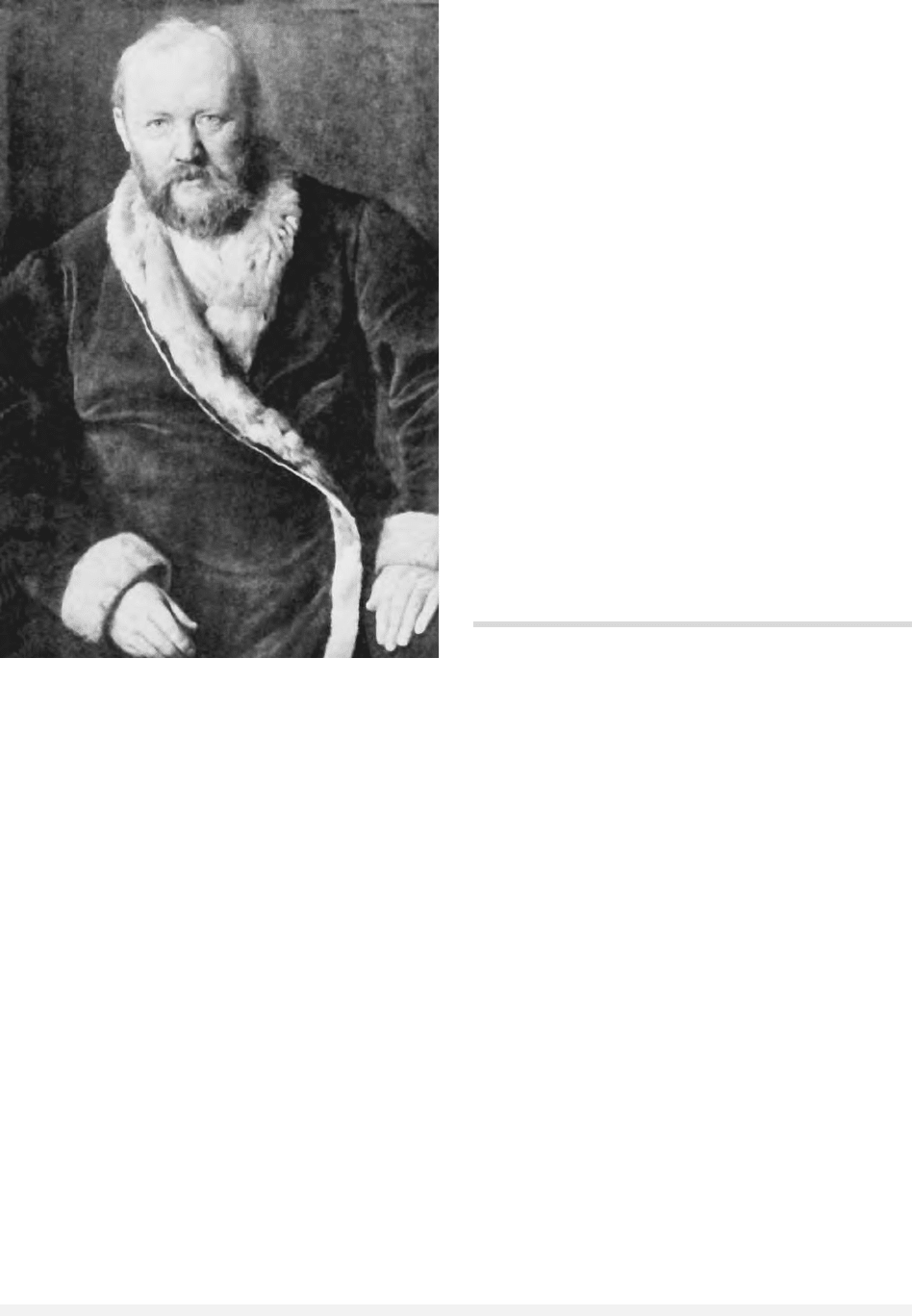Encyclopedia of Russian History
Подождите немного. Документ загружается.


OSORINA, YULIANYA USTINOVNA
(d. 1604), noblewoman, local saint of Murom.
Yulianya Osorina is known through the Life [or
Tale] of Yulianya Lazarevskaya, a remarkable docu-
ment of the seventeenth century. Written by the
saint’s son Druzhina Osorin in the 1620s or 1630s,
it stands out among vitae (lives of saints) in that
it is tied to precise historical time and events. Most
striking is its subject: an ordinary laywoman, the
only Russian saint who was not a martyr, ruler,
or nun.
Yulianya was born into a family of the upper
ranks of the service nobility. Her father, Ustin
Nedyurev, was a cellarer of Ivan IV; her mother
was Stefanida Lukina from Murom. Orphaned at
the age of six, Yulianya was brought up by female
relatives and proved to be a serious, obedient, and
God-loving child. At the age of sixteen she was
married to the wealthy servitor Georgy Osorin. The
Life throws some light on the wide scope of duties
expected of a noblewoman of that time. Osorina’s
parents-in-law passed on to her the supervision of
all household affairs; in the frequent absence of her
husband she ran the estate and managed family af-
fairs: for instance, giving an adequate burial and
commemoration to her mother- and father-in-law.
The Life shows no trace of the alleged seclusion that
has been usually postulated for Muscovite women
of some status.
Yulianya began helping widows and orphans
in her youth and continued the commitment after
marriage. During her widowhood she intensified
the charity work, giving away all but the most
basic material necessities. Having donated all her
belongings in the years of the terrible famine
(1601–1603), she died in poverty on January 2,
1604.
The genre of the Life has been disputed widely.
In 1871 Vasily Osipovich Klyuchevsky was the
first to describe it as a secular biography. The So-
viet scholar Mikhail Osipovich Skripil shared this
view and chose for his 1948 edition the title Tale
of Ulianya Osorina, abolishing traditional headings
such as Life of Yulianya Lazarevskaya. On the other
hand, Western scholars T. A. Greenan and Julia
Alissandratos, as well as the Russian philolologist
T. R. Rudi, insist on the hagiographic character of
the work. Different signs of saintliness can be found
in the Life: For instance, when Yulianya died,
“everyone saw around her head a golden circle just
like the one that is painted around the heads of
saints on icons.” When in 1615 her son was buried
and her coffin opened, “they saw it was full of
sweet-smelling myrrh,” which turned out to be
healing. According to Greenan, the Life is firmly
rooted in Russian religious tradition, especially in
the popular fourteenth-century collection Iz-
maragd, which emphasizes the possibility of salva-
tion in the world, a central theme in the Life.
The Life was meant both to edify and to ad-
vance the cause of Yulianya. Though there is no
indication of an official sanctification, she has been
worshipped as a saint since the latter half of the
seventeenth century in and around the village of
Lazarevo, near Yulianya’s burial site in Murom.
She is commemorated on October 15 and January
2. Her relics are preserved in the Murom City Mu-
seum.
See also: HAGIOGRAPHY; RELIGION; SAINTS
BIBLIOGRAPHY
Greenan, T. A. (1982). “Iulianiya Lazarevskaya.” Oxford
Slavonic Papers 15:28–45.
Howlett, Jana, tr. (2002). “The Tale of Uliania Osor’ina.”
Available at <http://www.cus.cam.ac.uk/~jrh11/
uliania.html>.
N
ADA
B
OSKOVSKA
OSTARBEITER PROGRAM See WORLD WAR II.
OSTROMIR GOSPEL
The Ostromil Gospel is an eleventh-century Gospel
book, and the earliest dated Slavic manuscript.
According to its postscript, the Ostromir Gospel
was copied by the scribe Gregory for the governor
(posadnik) of Novgorod, Ostromir, in 1056 and 1057.
The manuscript contains 294 folios, and each folio
is divided into two columns. Gospels or evangeliaries
were books of Gospel readings arranged for use in
specific church services. In the Slavic tradition they
were called aprakos Gospel, which derives from the
Greek for “holy day.” Because of their important
function in the celebration of the liturgy, they were
very frequently copied. There are two types of evan-
geliaries. Short evangeliaries contain readings for all
days of the cycle from Palm Sunday until Pentecost
and for Saturday and Sunday for the remainder of
OSTROMIR GOSPEL
1123
ENCYCLOPEDIA OF RUSSIAN HISTORY

the year. Full evangeliaries have Saturday and Sun-
day readings for Lent as well as for all days of the
week for the rest of the year. The Ostromir Gospel
is the oldest of the short evangeliaries. It is notable
for its East Slavic dialect features, its remarkable
miniatures depicting three of the Gospel writers, and
its dignified uncial writing, which was often used in
copying biblical texts. Some scholars have main-
tained that the Ostromir Gospel goes back to an East
Bulgarian reworking of an earlier Macedonian
Glagolitic text, while others deny a Glagolitic con-
nection. The pioneering Russian philologist Alexan-
der. Vostokov produced an influential edition of the
Ostromir Gospel in 1843 (reprint 1964). Facsimile
editions were published in St. Petersburg/Leningrad
in 1883 and 1988. First preserved in the St. Sophia
cathedral in Novgorod and then in one of the Krem-
lin churches in Moscow, the Ostromir Gospel is now
located in the Russian National Library in St. Peters-
burg (formerly the State Public Library).
See also: KIEVAN RUS; RELIGION
BIBLIOGRAPHY
Schenker, Alexander, M. (1995). The Dawn of Slavic: An
Introduction to Slavic Philology. New Haven, CT: Yale
University Press.
D
AVID
K. P
RESTEL
OSTROVSKY, ALEXANDER NIKOLAYEVICH
(1823–1886), playwright and advocate of drama-
tists’ rights.
Alexander Nikolayevich Ostrovsky wrote and
coauthored some fifty plays, translated foreign
plays into Russian, and worked tirelessly to im-
prove conditions for actors, dramatists, and com-
posers. Half a dozen of his works form the core
repertory for the popular theater movement, a se-
ries of initiatives to advance enlightenment and
acculturation that steadily expanded theater pro-
duction and attendance in Russia from the 1860s
to World War I.
Young Ostrovsky studied languages, ancient
and modern, with tutors and his stepmother, a
Swedish baroness. While a student at Moscow Uni-
versity, he regularly attended performances at the
Maly Theater. A civil service position, as clerk in
the Commercial Court, acquainted him with the
subculture of the Russian merchantry in the “Over-
the-River” district south of the Kremlin in the
1840s. Merchants then seemed exotic to educated
Russians because, like the peasants, they had re-
sisted Westernization, maintained the patriarchal
family life and customs prevalent from the six-
teenth century, and held a strictly formal attitude
toward legality. Ostrovsky’s first published work,
revised as It’s a Family Affair—We’ll Settle It Our-
selves (1849) brought him to the attention of the
publisher of the journal The Muscovite, and he be-
came its editor in 1850. In his “Slavophile period”
Ostrovsky set out to explore with a circle of friends
what was good and unique about Russians. They
studied and sang folk songs and frequented tav-
erns, especially at festival times, to savor the witty
repartee between factory hands and performers.
Ostrovsky would go on to write historical plays
that let him exploit the pithy Russian of the six-
teenth and seventeenth centuries that predated the
language’s syntactical remodeling and massive bor-
rowing of foreign words. In this way, and by fo-
cusing on cultural enclaves that had survived into
the modern period, Ostrovsky mined the equivalent
of an Elizabethan linguistic vein for dramatic pur-
poses. A new regime in politics brought him an un-
paralleled opportunity to steep himself in the living
residue of Old Russian. After the Crimean War,
Alexander II’s Naval Ministry commissioned pro-
fessional writers to go to various river ports and
describe the local people and manners. Ostrovsky,
assigned a section of the Volga, traveled there in
1856 and 1857. He noted on index cards hundreds
of unfamiliar words and expressions with examples
of usage. As he traveled, he observed how the
steamship and other innovations were undercutting
ancient patterns of courtship and family organiza-
tion and overturning assumptions about the world.
His best-known play, The Storm (1859), which
drew on this experience, won the prestigious
Uvarov prize for literature. It shows the old ways—
at their harmonious best and despotic worst—
compromised by a transportation revolution that
was shrinking space and accelerating time, and ur-
banization that promoted civic life as a value while
redefining public and private space. Commercial
prosperity and a scientific outlook increasingly
sanctioned individual autonomy and rights.
From the beginning, Ostrovsky wrote in a re-
alist style, freely depicting the rude manners and
behavior observable in actual life. For a time this
caused censors to deny permission to perform his
plays. But as cultural nationalism advanced, his
OSTROVSKY, ALEXANDER NIKOLAYEVICH
1124
ENCYCLOPEDIA OF RUSSIAN HISTORY

Playwright Alexander Ostrovsky.
portrayal of strengths set in relief by flaws and
crudeness became irresistible. His true-to-life situ-
ations made his plays enormously accessible. He
seemed to define “Russianness” by showing indi-
viduals confronting concrete social and ethical
dilemmas as they moved beyond the traditional
culture, where custom dictated behavior.
In 1881 he drafted a proposal for a Russian na-
tional theater, which appealed to Alexander III’s
Great Russian chauvinism by arguing that the ex-
istence of a Russian school of painting and Rus-
sian music gave reason to hope for a Russian school
of dramatic art. He claimed that an already extant
body of Russian plays demonstrated the ability to
teach the “powerful but coarse peasant multitude
that there is good in the Russian person, that one
must look after and nurture it in oneself.”
When Ostrovsky died at Shchelykova, his
country estate located between the Volga towns of
Kostroma and Kineshma, he was at his desk trans-
lating one of Shakespeare’s plays into Russian. In
the Soviet period a community for retired actors
would be built on the property. His plays continue
to be performed in Russia to enthusiastic audiences.
The richness of their language and the deft incor-
poration of folk songs and dances in the works of
his Slavophile period ensure their survival, even as
the historical nuances of authority and status that
motivate much of the action recede from living
memory.
See also: SLAVOPHILES; THEATER
BIBLIOGRAPHY
Hoover, Marjorie L. (1981). Alexander Ostrovsky. Boston:
Twayne Publishers.
Thurston, Gary. (1998). The Popular Theatre Movement in
Russia, 1862–1919. Evanston, IL: Northwestern Uni-
versity Press.
Wettlin, Margaret. (1974). “Alexander Ostrovsky and the
Russian Theatre before Stanislavsky.” In Alexander
Ostrovsky: Plays. Moscow: Progress Publishers.
G
ARY
T
HURSTON
OTREPEV, GRIGORY
(c. 1580–1606), Russian monk who supposedly be-
came the false Tsar Dmitry.
Yuri Bogdanovich Otrepev, the son of an in-
fantry officer, became the monk Grigory as a
teenager and eventually entered the prestigious
Miracles Monastery in the Moscow Kremlin. There
he became a deacon, and his intelligence and good
handwriting soon brought him to the attention
of Patriarch Job (head of the Russian Orthodox
Church), who employed Grigory as a secretary.
In 1602 a group of monks, including Grigory
and the future Tsar Dmitry, fled to Poland-
Lithuania. Their departure greatly upset Tsar Boris
Godunov and Patriarch Job. When one of the run-
aways identified himself as Dmitry of Uglich (the
youngest son of Tsar Ivan IV who supposedly died
as a child), the Godunov regime launched a propa-
ganda campaign identifying “False Dmitry” as
Grigory Otrepev. Stories were fabricated that Grig-
ory had become a sorcerer and tool of Satan or that
he had committed crimes while in the service of the
Romanov family (opponents of Tsar Boris). Al-
though no credible witnesses ever came forward to
verify that Grigory and “False Dmitry” were the
OTREPEV, GRIGORY
1125
ENCYCLOPEDIA OF RUSSIAN HISTORY

same person, Tsar Dmitry’s enemies never tired of
claiming that he was really Otrepev.
The sensational image of the evil, debauched,
and bloodthirsty monk Grigory pretending to be
Tsar Dmitry continues to haunt modern scholar-
ship. Many historians have accepted at face value
the most lurid propaganda manufactured by
Dmitry’s enemies, but careful study of the evidence
reveals that it is impossible to merge the biogra-
phies of Grigory and “False Dmitry.” Grigory
Otrepev was last seen by an English merchant
shortly after the assassination of Tsar Dmitry in
1606; then he disappeared.
See also: DMITRY, FALSE; GODUNOV, BORIS FYODOR-
OVICH; TIME OF TROUBLES
BIBLIOGRAPHY
Dunning, Chester. (2001). Russia’s First Civil War: The
Time of Troubles and the Founding of the Romanov Dy-
nasty. University Park: Pennsylvania State Univer-
sity Press.
Perrie, Maureen. (1995). Pretenders and Popular Monar-
chism in Early Modern Russia: The False Tsars of the
Time of Troubles. Cambridge, UK: Cambridge Uni-
versity Press.
C
HESTER
D
UNNING
OUR HOME IS RUSSIA PARTY
Our Home Is Russia (Nash Dom—Rossiya, or NDR)
was a sociopolitical movement and a ruling party
from 1996 to 1998. Formed in the spring of 1995
according to a plan of the president’s administration
as one of two ruling parties—the party of the “right
hand,” with the prime minister at the head—it im-
mediately launched forward. The NDR movement’s
council, founded in May 1995 with Victor Cher-
nomyrdin at the head, included thirty-seven heads
of regions, a few ministers, and heads of large in-
dustrial enterprises and banks. The federal NDR
list for the Duma elections was headed by Cher-
nomyrdin, the famous film director Nikita Mikhal-
kov, and General Lev Rokhlin, a Chechnya war hero.
Subsequently both the prime minister and the film
director renounced the mandates, and Rokhlin, en-
tering the Duma, soon came into opposition against
Boris Yeltsin and he then left the NDR fraction; and
founded the Movement in Support of the Army. The
NDR list received seven million votes (10.1%, third
place) and forty-five Duma seats; this was taken as
defeat of the ruling party. In the single-mandate dis-
tricts, out of 108 proposed candidates, ten were
elected. In the 1996 presidential elections, NDR backed
Yeltsin.
With Chernomyrdin leaving the prime minis-
tership in the spring of 1998, NDR entered a period
of crisis. The effort on the part of the young ambi-
tious leader of the NDR fraction in the Duma,
Vladimir Ryzhkov, to turn NDR from a party of
heads into a neoconservative political party of “val-
ues” proved unsuccessful. Discussions of merging
with the blocs A Just Cause and Voice of Russia and
the movement New Force were fruitless as well. Al-
lies of NDR in the elections amounted to the weak
Forward, Russia of Boris Fyodorov and the Muslim
movement Medzhlis. The programmatic positions of
NDR amount to moderate-reformist ideas and a de-
claration of conservative-liberal values. The federal
list was headed by Chernomyrdin and the Saratov
governor Dmitry Ayatskov. NDR did not make it
into the Duma, as it received 0.8 million votes (1.2
percent). Nine NDR candidates from single-mandate
districts, including Chernomyrdin and Ryzhkov, en-
tered the pro-government fraction Unity and the
group People’s Deputy. In May 2000, the eighth and
last congress of NDR, which at the time had 125,000
members, decided to form part of the party Unity,
created on the foundation of the movements Unity,
All Russia, and NDR.
See also: CHERNOMYRDIN, VIKTOR STEPANOVICH; MOVE-
MENT IN SUPPORT OF THE ARMY; UNITY (MEDVED)
PARTY
BIBLIOGRAPHY
McFaul, Michael. (2001). Russia’s Unfinished Revolution:
Political Change from Gorbachev to Putin. Ithaca, NY:
Cornell University Press.
McFaul, Michael, and Markov, Sergei. (1993). The Trou-
bled Birth of Russian Democracy: Parties, Personalities,
and Programs. Stanford, CA: Hoover Institution Press.
Reddaway, Peter, and Glinski, Dmitri. (2001). The Tragedy
of Russia’s Reforms: Market Bolshevism against Democ-
racry. Washington, DC: U.S. Institute of Peace Press.
N
IKOLAI
P
ETROV
OUR HOME IS RUSSIA PARTY
1126
ENCYCLOPEDIA OF RUSSIAN HISTORY

PACIFIC FLEET
The Pacific Fleet is headquartered in Vladivostok,
capital of the Maritime (Primorsky) Territory. Not
surprisingly, given Russia’s status as a Pacific na-
tion with vital interests in the Asia-Pacific region,
the Pacific Fleet is one of Russia’s most powerful
naval forces. The city of Vladivostok, established in
1860, occupies most of Muraviev-Amursky Penin-
sula, named after the governor general of Eastern
Russia during the mid-nineteenth century. Two
bays, Amursky and Ussurysky, wrap the penin-
sula, mirroring with their names two great rivers
of the Russian Far East, the Amur, and the Ussury,
its tributary.
Beginning in the 1600s, Russian explorers first
reached Siberia’s eastern coastline and founded the
city of Okhotsk (1647). Until the mid-1800s, how-
ever, China’s dominance of the southern regions of
eastern Siberia restricted Russian naval activities.
The construction of the port city of Vladivostok in-
tensified Russia’s need for adequate transportation
links. Tsar Alexander III drew up plans for the
Trans-Siberian Railway and began building it in
1891. Despite the enormity of the project, a con-
tinuous route was completed in 1905, stimulated
by the outbreak of the Russo-Japanese War a year
earlier. Vladivostok became Russia’s main naval
base in the east after Port Arthur (located in Chi-
nese territory and ceded to Russia in 1898) fell in
January 1905 during the war. After World War I,
Japan seized Vladivostok and held the key port for
four years, initially as a member of the Allied in-
terventionist forces that occupied parts of Russia
after the new Bolshevik government proclaimed
neutrality and withdrew from the war. At the end
of World War II, Stalin broke the neutrality pact
that had existed throughout the war in order to
occupy vast areas of East Asia formerly held by
Japan. It was through Vladivostok, moreover, that
some of the Lend-Lease aid, the most visible sign
of U.S.-Soviet cooperation during World War II,
passed on its way to Murmansk.
The Pacific Fleet includes eighteen nuclear sub-
marines that are operationally subordinate to the
Ministry of Defense and based at Pavlovsk and Ry-
bachy. The blue-water striking power of the Pacific
Fleet lies in thirty-four nonnuclear submarines and
forty-nine principal surface combatants. The Zvezda
Far Eastern Shipyard in Bolshoi Kamen, a couple of
hours north of Vladivostok, serves as the chief re-
cycling facility for the Fleet, although it is in dis-
repair. The Pacific Fleet’s additional home ports
P
1127

include Petropavlovsk-Kamchatsky, Magadan, and
Sovetskaya Gavan. As far as air power is concerned,
the Pacific Fleet consisted during the mid-1990s of
250 land-based combat aircraft and helicopters.
Two bomber regiments stationed at Alekseyevka
constituted its most powerful strike force. Each
regiment consisted of thirty supersonic Tu-22M
Backfire aircraft. The land power of the Pacific Fleet
consisted of one naval infantry division and a
coastal defense division. The naval infantry divi-
sion included more than half of the total manpower
in the Russian naval infantry. During the mid-
1990s, the Pacific Fleet infantry was reorganized
into brigades.
During the late 1990s, a joint headquarters was
established commanding the land, naval, and air
units stationed on the Kamchatka Peninsula. De-
spite funding shortfalls during the early twenty-
first century, the Russian Pacific Fleet continues to
demonstrate its resolve to increase combat readi-
ness. Russian Pacific Fleet submarines carry out
missions of regional security, strategic deterrence,
protection of strategic assets, and training for anti-
surface warfare.
See also: BALTIC FLEET; BLACK SEA FLEET; MILITARY, IM-
PERIAL ERA; MILITARY, SOVIET AND POST-SOVIET;
NORTHERN FLEET; TRANS-SIBERIAN RAILWAY
BIBLIOGRAPHY
Busmann, Gerd, and Meier, Oliver. (1997). The Nuclear
Legacy of the Former Soviet Union: Implications for
Security and Ecology. Berlin: Berliner Information-
szentrum für Transatlantische Sicherheit (BITS) in
cooperation with Heinrich-Böll-Stiftung.
Da Cunha, Derek. (1990). Soviet Naval Power in the Pa-
cific. Boulder, CO: Lynne Rienner.
Morris, Eric. (1977). The Russian Navy: Myth and Real-
ity. New York: Stein and Day.
Stephan, John J. (1994). The Russian Far East: A History.
Stanford, CA: Stanford University Press.
J
OHANNA
G
RANVILLE
PAGANISM
Due to the concerted efforts of both the eastern and
western churches, Christianity largely replaced
Slavic paganism during the course of the ninth and
tenth centuries. There are primarily three sources
for information about Slavic paganism: written
accounts, archaeological discoveries, and ethno-
graphic evidence. As literacy was introduced to the
East Slavs only with their conversion to Christian-
ity in 988
C
.
E
., and the written sources were most
often compiled by Christian monks or missionar-
ies, much of what is known about East Slavic pa-
ganism from written accounts is of questionable
accuracy. The sources begin with the Byzantine
historian Procopius (sixth century) and include
Arab travel accounts, reports of Christian mission-
ary activity, and references in the Primary Chroni-
cle and the First Novgorod Chronicle. Archaeological
evidence has provided some information on pagan
temples, particularly among the West Slavs on the
island of Rügen in the Baltic Sea. In addition, what
may have been a temple to Perun, god of thunder,
was excavated near Peryn, south of Novgorod in
1951, and several sites that were likely associated
with cult practices have been found at Pskov, in
the Smolensk region, and Belarus. Generally, how-
ever, archaeological sites are able to provide more
information about material culture than about the
spiritual life of a preliterate people. Ethnographic
material was not systematically collected until the
nineteenth century, which makes it difficult to sep-
arate genuine information from later accretions.
One can summarize, based on evidence from all
these sources, however, that early Slavic religion
was animistic, in that it personified natural ele-
ments. It also deified heavenly bodies and recog-
nized the existence of various spirits of the forest,
water, and household. Ritual sacrifice was likely
used to appease the pagan deities, and amulets were
used to ward off evil. In accordance with wide-
spread Indo-European practice, the early Slavs
likely cremated their dead, but even before the
Christian era burial was also practiced. Chernaya
Mogila, a burial site in Chernigov that dates from
the tenth century provides strong evidence for a be-
lief in the afterlife, as three members of a princely
family were interred with the horses, weapons, and
utensils that they would need for existence in the
next world.
Procopius makes reference to a Slavic god who
is the ruler of everything, but evidence for a larger
pantheon comes much later. The twelfth-century
Primary Chronicle relates how Prince Vladimir set
up idols in the hills of Kiev to Perun, “made of wood
with a head of silver and a mustache of gold,” as
well as to Khors, Dazhbog, Stribog, Simargl, and
Mokosh. In the entries for 907 and 971
C
.
E
., the
chronicle reports that the Rus swore by their gods
Perun and Volos, the god of the flocks. Perun is
PAGANISM
1128
ENCYCLOPEDIA OF RUSSIAN HISTORY

associated with thunder and the oak tree, thought
to be a favorite target of the lightning bolts un-
leashed by the thunder god. Much less is known
about the other gods mentioned in the chronicle.
Khors seems to refer to the sun and, as Jakobson
points out, is closely connected with Dazhbog, the
“giver of wealth,” and Stribog, “the apportioner of
wealth.” Simargl appears to be a form of Simorg,
the Iranian winged monster, who is at times de-
picted as a winged dog. The only female in the pan-
theon is Mokosh, whose name is probably derived
from moist, and who is likely a personification of
Moist Mother Earth. Some scholars view Mokosh
as a remnant of the Great Goddess cult, which
struggled against the patriarchal religion of the
Varangians (Vikings). The god Volos, identified in
the peace treaties as the god of cattle, may be
connected with death and the underworld. The as-
sociation with cattle possibly comes from the ef-
forts of Christian writers to connect him with St.
Blasius, a martyred Cappadocian bishop who be-
came the protector of flocks. Although not listed
in Vladimir’s pantheon, the god Rod, with his con-
sort Rozhanitsa, is mentioned in other East Slavic
sources as a type of primordial progenitor.
After the conversion of Rus, elements of pa-
ganism continued in combination with Christian
beliefs, a phenomenon that has been called “dvoev-
erie” or “dual belief” in the Slavic tradition. Refer-
ences to pagan deities occasionally occur in Christian
era texts, most notably as rhetorical ornamenta-
tion in such works as the Slovo o polku Igoreve. Syn-
cretism is also apparent in the transformation of
Perun into the Old Testament Elijah, who was taken
to heaven in a fiery chariot.
See also: DVOEVERIE; KIEVAN RUS; OCCULTISM; VIKINGS
BIBLIOGRAPHY
Barford, Paul M. (2001). The Early Slavs: Culture and So-
ciety in Early Medieval Eastern Europe. Ithaca, NY:
Cornell University Press.
Gimbutas, Marija. (1971). The Slavs. London: Thames
and Hudson.
Hubbs, Joanna. (1989). Mother Russia: The Feminine Myth
in Russian Culture. Bloomington: Indiana University
Press.
Jakobson, Roman. (1950) “Slavic Mythology.” Funk and
Wagnalls Standard Dictionary of Folklore, Mythology
and Legend. Vol. 2. New York: Funk and Wagnalls.
The Russian Primary Chronicle: Laurentian Text. (1953).
Ed. and tr. Samuel Hazzard Cross and Olgerd P.
Sherbowitz-Wetzor. Cambridge, MA: The Mediaeval
Academy of America.
D
AVID
K. P
RESTEL
PAKISTAN, RELATIONS WITH
An affinity between Pakistan and the Soviet Union
would have seemed natural, given the Pakistan’s
status as a British colony (until 1947) and the
Soviet Union’s role as supporter of nations op-
pressed by capitalist imperialists. However, in 1959
Pakistan—along with Turkey and Iran—joined the
Central Treaty Organization (CENTO), which was
engineered by President Dwight Eisenhower’s ener-
getic secretary of state, John Foster Dulles. The se-
curity treaty replaced the Baghdad Pact and was
intended to provide a southern bulwark to Soviet
expansion toward the Indian Ocean and the oil
fields of the Persian Gulf. CENTO also enabled the
United States to aid Pakistan and cement a close se-
curity relationship with the country that has thus
become the cornerstone of U.S. policy in South Asia
for more than three decades. This relationship re-
inforced Moscow’s efforts to maintain close rela-
tions with Pakistan’s rival, India. Beginning in June
1955 with Indian prime minister Jawaharlal
Nehru’s visit to Moscow, and First Secretary Nikita
Khrushchev’s return trip to India during the fall of
1955, the foundations were laid for cordial Soviet-
Indian relations. While in India, Khrushchev an-
nounced Moscow’s support for Indian sovereignty
over the Kashmir region. Leading to the eventual
partition of British India in 1947, contention be-
tween Hindus and Muslims has focused on Kash-
mir for centuries. Pakistan asserts Kashmiris’ right
to self-determination through a plebiscite in accor-
dance with an earlier Indian pledge and a United
Nations resolution. This dispute triggered wars be-
tween the two countries, not only in 1947 but also
in 1965 (Moscow maintained neutrality in 1965).
In December 1971, Pakistan and India again went
to war, following a political crisis in what was then
East Pakistan and the flight of millions of Bengali
refugees to India. The two armies reached an im-
passe, but a decisive Indian victory in the east re-
sulted in the creation of Bangladesh.
New strains appeared both in Soviet-Pakistani
relations after the 1979 Soviet invasion of Afghani-
stan. Pakistan supported the Afghan resistance,
while India implicitly supported Soviet occupation.
Pakistan accommodated an influx of refugees (more
PAKISTAN, RELATIONS WITH
1129
ENCYCLOPEDIA OF RUSSIAN HISTORY

than 3.2 million people) resulting from the Soviet
occupation (December 1979–February 1989). In the
following eight years, the USSR and India voiced
increasing concern over Pakistani arms purchases,
U.S. military aid to Pakistan, and Pakistan’s nu-
clear weapons program. In May 1998 India, and
then Pakistan, conducted nuclear tests.
After the September 11, 2001, terrorist attacks,
Pakistan’s relations with Washington grew strained,
while its relations with Moscow improved. Al-
though Pakistan’s military ruler, General Pervez
Musharraf, agreed to provide the United States
with bases in Pakistan for launching military op-
erations against Pakistan’s erstwhile ally—the
Taliban—in Afghanistan, his actions fueled elec-
toral successes of Islamic fundamentalists in Pak-
istan who opposed his pro-U.S. stance. Meanwhile,
Russian President Vladimir Putin played a key me-
diation role in the Indo-Pakistani conflict. In Feb-
ruary 2003, Musharraf met with Putin in Moscow
to discuss trade and defense ties. This was the first
official state visit by a Pakistani leader to Moscow
since Zulfiqar Ali Bhutto in the 1970s. Pakistan and
India massed about a million troops along the UN-
drawn Line of Control that divides their sectors of
the state officially called Jammu and Kashmir—
raising international fears of a possible nuclear war.
See also: AFGHANISTAN, RELATIONS WITH
BIBLIOGRAPHY
Hershberg, Eric, and Moore, Kevin W. (2002). Critical
Views of September 11: Analyses from Around the
World. New York: New Press.
Jones, Owen Bennett. (2002). Pakistan: Eye of the Storm.
New Haven, CT: Yale University Press.
Weaver, Mary Anne. (2002). Pakistan: in the Shadow of
Jihad and Afghanistan. New York: Farrar, Straus and
Giroux.
Wirsing, Robert. (1994). India, Pakistan, and the Kashmir
Dispute: On Regional Conflict and Its Resolution. New
York: St. Martin’s Press.
J
OHANNA
G
RANVILLE
PALEKH PAINTING
Palekh painted lacquer boxes, popularly thought to
be a traditional Russian folk art, were actually a
product of the Soviet period. Palekh painting, a del-
icate and elegant miniature style, is done on the lids
of lacquered, papier-mâché black boxes with crim-
son interiors. The subjects depict Russian fairy tales,
legends, and folk heroes, and during the Soviet pe-
riod also included scenes of rural life, industrial-
ization, and Soviet leaders and heroes. Palekh boxes,
originally created for Soviet citizens, developed a
worldwide reputation after being sold at interna-
tional arts and crafts fairs.
The term palekh comes from the most famous
of the three villages (Kholui, Mstera, and Palekh) in
which Palekh painting originated. Ivan Golikov, a
Palekh icon painter, derived the inspiration for this
style from lacquered boxes he saw at the Kustar
Museum in 1921. Golikov and others applied egg
tempera, rather than oil, to papier-mâché boxes
and, employing techniques used in icon painting,
created objects that resembled traditional folk art.
The Artel of Early Painting, a craft collective for
Palekh painters founded by Golikov and his col-
leagues, was established in Palekh in 1924 (artels
also existed in Khuloi and Mstera). Palekh painting
became an integral part of Soviet applied arts with
the establishment of a four-year training program.
Exhibitions dedicated to Palekh boxes were held
throughout the 1930s. Academic articles on this
medium, and artistic debates discussing the appro-
priate style and content of Palekh painting, con-
tinued from the 1930s to the 1960s. Since the
1970s, Palekh painted boxes and brooches have
been viewed as the quintessential tourist souvenir
from Russia.
See also: FOLKLORE
BIBLIOGRAPHY
Hilton, Alison. (1995). Russian Folk Art. Bloomington:
Indiana University Press.
K. A
NDREA
R
USNOCK
PALE OF SETTLEMENT
As a result of the Napoleonic Wars and the acqui-
sition of the central and eastern provinces of Poland
by the Russian Empire during the late eighteenth
century, the area extending from the Baltic to the
Black Sea became known as the Russian “Pale of
Settlement.” Originally established by Catherine the
Great in 1791, the Pale (meaning “border”) even-
tually covered roughly 286,000 square miles
(740,700 square kilometers) of territory and grew
PALEKH PAINTING
1130
ENCYCLOPEDIA OF RUSSIAN HISTORY

to include twenty-five provinces (fifteen Russian
and ten Polish), including Kiev, Grodno, Minsk,
Lublin, Bessarabia, and Mogilev. Along with the fa-
vorable acquisition of Polish land, the Russian gov-
ernment was faced with a population of ethnic
groups that came with the various territories. Al-
though the territories consisted of various groups,
including Byzantine Catholics, Germans, Armeni-
ans, Tartars, Scots, and Dutchmen, it was the large
number of Jews (10% of the Polish population) that
was most troubling to the tsars.
In 1804, intending to protect the Russian pop-
ulation from the Jewish people, Alexander I issued
a decree that prevented Jews from living outside the
territories of the Pale, the first of many statutes de-
signed to limit the freedoms of Russia’s new Jewry.
With more than five million Jews eventually living
and working within its borders, Russian lawmak-
ers used the confines of the Pale as an opportunity
to limit Jewish participation in most facets of so-
cial, economic, and political life. With few excep-
tions, Jews were forced to reside within the Pale’s
overcrowded cities and small towns called shtetls,
restricted from traveling, prevented from entering
various professions (including agriculture), levied
with extra taxation, forbidden to receive higher ed-
ucation, and kept from engaging in various forms
of trade to subsidize their livelihood. Although Jews
in the Pale were destined to a endure a life of poverty
and restriction, most managed to make their way
into the local economies by working as tailors, cob-
blers, peddlers, and small shopkeepers. Others, who
were less fortunate, survived only by committed
mutual aid efforts and strong local networks of
support.
As the Russian Empire started experiencing the
early stages of industrialization during the 1880s,
the Pale began to witness a steady decline in its
agricultural, artisanal, and petty entrepreneurial
economies. Because of this transition, many inde-
pendent producers of goods and services could no
longer subsist and were forced to find jobs in fac-
tories. Very few, especially the Jewish artisans and
tailors, were able to continue producing indepen-
dently or as middlemen to larger manufacturing
plants. By the start of the twentieth century, the
manufacturing sector was increasingly becoming
the primary source of employment in the Pale, with
wage laborers producing cigarettes, cigars, knit
goods, gloves, textiles, artificial flowers, buttons,
glass, bricks, soap, candy, and various other goods.
It was ultimately the deteriorating economy within
the Pale, coupled with years of anti-Semitism, that
served as catalyst for more than two million Jews
to emigrate to America between 1881 and 1914.
Not long after this exodus, the Pale of Settlement
was abolished with the overthrow of the tsarist
regime in 1917.
See also: ALEXANDER I; BESSARABIA; CATHERINE II; JEWS;
NATIONALITIES POLICIES, TSARIST
BIBLIOGRAPHY
Klier, John. (1986). Russia Gathers Her Jews: The Origins
of the “Jewish Question” in Russia, 1772–1825. DeKalb:
Northern Illinois University Press.
Ro’i, Yaacov, ed. (1995). Jews and Jewish Life in Russia
and the Soviet Union. Portland, OR: Frank Cass.
D
IANA
F
ISHER
PALEOLOGUE, SOPHIA
(d. 1503) niece of the last two Byzantine emperors
and the second wife of Grand Prince Ivan III of
Moscow.
Sophia Paleologue (Zoe) improved the Russian
Grand Prince’s international standing through her
dynastic status and promoted Byzantine symbol-
ism and ceremony at the Russian court.
Zoe Paleologue was the daughter of Despot
Thomas of Morea, the younger brother of the Byzan-
tine emperors John VIII and Constantine IX, and
Catherine, daughter of Prince Centurione Zaccaria
of Achaea. After the conquest of Morea by the Ot-
toman Turks in 1460 and her parents’ subsequent
death, Paleologue became a ward of the Uniate car-
dinal Bessarion, who gave her a Catholic education
in Rome as a dependent of Pope Sixtus IV.
After protracted negotiations with the Russian
Grand Prince, who saw an opportunity to increase
his prestige in a marital union with a Byzantine
princess, the Vatican offered Paleologue in a be-
trothal ceremony to one of Ivan III’s representa-
tives on June 1, 1472. During Paleologue’s trip to
Russia, the Byzantine princess assured the Russian
populace in Pskov of her Orthodox disposition by
abjuring Latin religious ritual and dress and by ven-
erating icons. Paleologue married Ivan III on No-
vember 12, 1472, in an Orthodox wedding ceremony
in the Moscow Kremlin and took the name Sophia.
Paleologue gave birth to ten children, one of
which was the future heir to the Russian throne,
PALEOLOGUE, SOPHIA
1131
ENCYCLOPEDIA OF RUSSIAN HISTORY

Basil III. The existence of Ivan Molodoy, the sur-
viving son of Ivan III’s union with his first wife,
Maria of Tver, and natural successor to the throne,
caused friction between the grand prince and Pale-
ologue. According to contemporary Russian chron-
icles, Paleologue intrigued against Ivan Molodoy
and his wife, Elena Voloshanka. Paleologue’s situ-
ation at court deteriorated even more after Volo-
shanka gave birth to a son, Dmitry Ivanovich. The
untimely death of Ivan Molodoy in 1490 inspired
rumors that Paleologue had poisoned him. The fo-
cus of Paleologue’s and Voloshanka’s dynastic
struggle shifted to Dmitry Ivanovich. Ivan III’s de-
cision to make Dmitry his heir in 1497 caused Pa-
leologue and her son Basil to revolt. Although Ivan
III disgraced Sophia and crowned Dmitry as his suc-
cessor in the following year, the Byzantine princess
emerged victorious in 1499, when Basil was made
Grand Prince of Novgorod and Pskov. Conspiring
with the Lithuanians, Paleologue put pressure on
her husband to imprison Voloshanka and her son
Dmitry and to proclaim Basil Grand Prince of
Vladimir and Moscow in 1502.
In pursuing her political and dynastic goals, Pa-
leologue exploited traditional Byzantine methods to
advertise her claims. In a liturgical tapestry she
donated to the Monastery of Saint Sergius of
Radonezh in 1498, she proclaimed her superior her-
itage by juxtaposing her position as Tsarevna of
Constantinople with the grand princely title of her
husband. By exploiting Byzantine religious sym-
bolism, in the same embroidery she expressed her
claim that Basil III was the divinely chosen heir to
the Russian throne. While there has been no sub-
stantiation for the claim of some scholars that Pa-
leologue was responsible for the introduction of
wide-ranging Byzantine ideas and practices at the
Russian court, the Byzantine princess’s knack for
political messages draped in religious language and
imagery undoubtedly left a lasting mark on me-
dieval Russian culture.
See also: BASIL III; IVAN III
BIBLIOGRAPHY
Fennell, J. L. I. (1961). Ivan the Great of Moscow. London:
Macmillan.
Fine, John V. A., Jr. (1966). “The Muscovite Dynastic
Crisis of 1497–1502.” Canadian Slavonic Papers
8:198–215.
Kollmann, Nancy Shields. (1986). “Consensus Politics:
the Dynastic Crisis of the 1490s Reconsidered.” Rus-
sian Review 45(3):235–267.
Miller, David. (1993). “The Cult of Saint Sergius of
Radonezh and Its Political Uses.” Slavic Review 52(4):
680–699.
Thyrêt, Isolde. (2001). Between God and Tsar: Religious
Symbolism and the Royal Women of Muscovite Russia.
DeKalb: Northern Illinois University Press.
I
SOLDE
T
HYRÊT
PALLAS, PETER-SIMON
(1741–1811), explorer, geologist, botanist.
Peter-Simon Pallas was born in Berlin, where
he received his formal education. He also spent
some time in Holland and England working in mu-
seums with rich collections in natural history. One
of his early studies dealing with polyps and sponges
was published in the Hague in 1761 and immedi-
ately attracted wide professional attention, not
only because of the richness and originality of the
presented empirical data, but also with its precisely
stated general theoretical propositions. In 1763
Pallas became a member of the St. Petersburg Acad-
emy of Sciences, and a year later he led an ex-
ploratory expedition to the Caspian and Baikal
areas, concentrating on both natural history and
ethnography. Published in three volumes between
1771 and 1778, under the title Travels through Var-
ious Provinces in the Russian Empire, and written in
German, the study was immediately translated into
Russian, and then into French, Italian, and English.
Pallas guided several other exploratory expeditions;
the trip to Southern Russia, with a heavy concen-
tration on Crimea, proved especially enlightening.
All these studies manifested not only Pallas’s ob-
servational talents but also his profound familiar-
ity with contemporary geology, botany, zoology,
mineralogy and linguistics. His Flora Rossica pro-
vided a systematic botanical survey of the coun-
try’s trees.
Pallas’s studies extended beyond the limits of
traditional natural history. He pondered the gen-
eral processes and laws related to geology: For ex-
ample, he presented a theory of the origin of
mountains in intraterrestrial explosions. He also
made a technically advanced study of regional vari-
ations in the Mongolian language, articulated a
transformist view of the living forms, which he
later abandoned, and, responding to a suggestion
made by Catherine II, worked on a comparative dic-
tionary. He also made a historical survey of land
tracts discovered by the Russians in the stretches
PALLAS, PETER-SIMON
1132
ENCYCLOPEDIA OF RUSSIAN HISTORY
